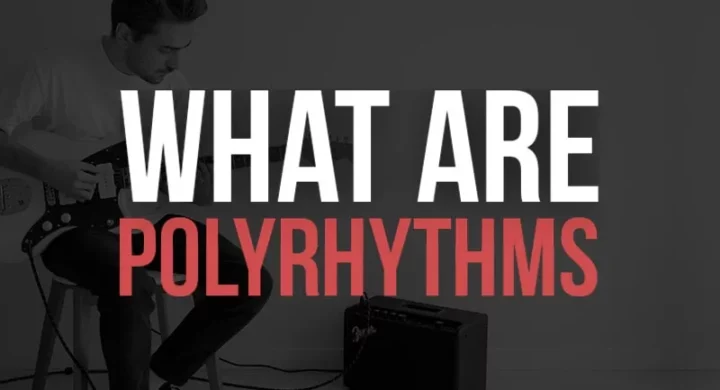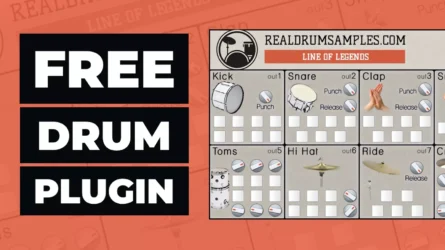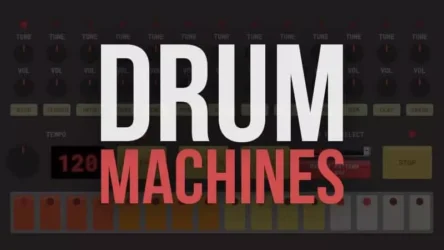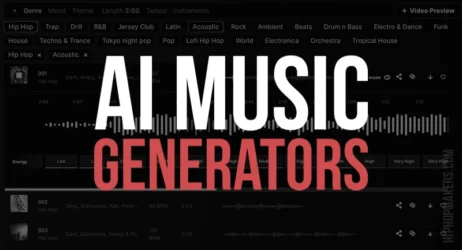This guide will answer what polyrhythms are in music, provide examples of polyrhythms, and the difference between polyrhythm and polymeter.
What Are Polyrhythms In Music?
Polyrhythms are commonly defined as two or more independent rhythms played simultaneously. These are two different rhythms playing at once to create a different resulting rhythm. Polyrhythms can be used in many areas of music, such as classical music, techno, rock, etc.
- What Are Polyrhythms
- Why Are Polyrhythms Used
- What Are Examples of Polyrhythms
- The Most Common Polyrhythms
- Polyrhythm vs. Polymeter
- How Do You Teach Polyrhythms
- Are Polyrhythms Difficult
- Cross Rhythms vs. Polyrhythms

What Are Polyrhythms?
Polyrhythms can be created by playing two different rhythms on two different instruments or dividing one rhythm into multiple parts and playing them simultaneously.
One of the most famous Polyrhythms is the 3 against 2 Polyrhythm found in the second movement of Beethoven’s 5th Symphony.
This polyrhythm is created by playing three beats against two beats. The three beats are played on the upbeat (the first beat in each measure), and the two beats are played on the downbeat (the second beat in each measure).
Polyrhythms can be very challenging to play, but they can also create a really interesting sonic texture. The two different rhythms played at once can create a third, separate rhythm.
What Is The Importance Of Polyrhythms In Music?
Polyrhythms are important in music because they create a more complex and interesting rhythm.
Using two or more different rhythms simultaneously can create harmony or tension that wouldn’t be possible with a single rhythm.
This can add depth and texture to your music and make it more interesting to listen to.
Many composers use polyrhythms in their music to show technical skill, as the polyrhythm is a much more difficult rhythm to play, as it requires a lot of coordination and musical skill.
Who Started Polyrhythms In Music?
There is no definitive answer to this question. It’s safe to say that polyrhythms have been around for as long as music itself and that various cultures and musical traditions have incorporated them into their music in unique and creative ways.
Some of the earliest known examples of polyrhythmic music are African drumming and dance traditions, where rhythms are often played or danced on two or more separate instruments simultaneously.
This type of rhythmic complexity can also be found in Celtic, Balkan, Latin American, and Indian music, to name just a few.
So while it’s impossible to say who exactly started using polyrhythms in music, it’s safe to say that they have been used for many years, in many cultures, and are an important part of music today.
Why Are Polyrhythms Used?
Polyrhythms are used in music because they provide a more complex and exciting rhythmic texture than what is possible with a single rhythm.
They can create the illusion of multiple beats happening simultaneously or produce an intricate web of rhythms that support and embellish the melody or underlying harmony.
Polyrhythms can be used to add excitement, complexity, and sophistication to music and are particularly popular in jazz and world music.
Polyrhythms create a feeling of tension and release, which can be pleasing to the ear. For example, if you listen to a simple melody played against a steady beat, the melody will sound more relaxed and mellow.
But adding another rhythmic layer that is offset from the first melody will create a sense of tension that makes the listener feel more engaged with the music.
Once the second rhythm resolves back into the first rhythm, it creates a sense of release that is pleasing to the ear. This tension and release mechanism is one of the primary reasons polyrhythms are used in music.
What Are Examples Of Polyrhythms?
Polyrhythms can be found in all forms of music, from classical to popular music. Here are a few examples:
1. Kashmir By Led Zeppelin
The opening riff of the Led Zeppelin song Kashmir is a polyrhythm. It consists of three notes played simultaneously – one on the bass strings, one on the middle strings, and one on the high strings – but each note sounds differently, creating the polyrhythm.
2. Rite of Spring By Igor Stravinsky
The climax of the orchestral piece Rite of Spring by Igor Stravinsky features a rapid-fire polyrhythm played by a large orchestra of violins and bassoons, supported by an irregular rhythm played on a bass drum and high-hat cymbal.
3. Take Five By The Dave Brubeck Quartet
The following polyrhythm example is one of the most famous examples of polyrhythms by Take Five by The Dave Brubeck Quartet, which features a 5/4 time signature. This means that there are five beats per measure instead of four, and each beat has a quarter-note value.
4. Sweet Child O’ Mine By Guns N’ Roses
Polyrhythm is prominently featured in Sweet Child O’ Mine by Guns N’ Roses, which is often referred to as the greatest guitar solo of all time. Slash starts out playing what sounds like a normal 4/4 rhythm, but then adds another rhythm on top of it. The result is a complex, syncopated melody that sounds great with the rest of the music.
5. Strobe By Deadmau5
One of the most beautiful and popular songs from deadmau5, Strobe is literally composed pretty much entirely of polyrhythms. Most of the elements in the song are multiples of three, with a few bars that have elements at other divisions as well.
What Are The Most Common Polyrhythms?
The most common polyrhythms are 3 against 2, 5 against 4, and 7 against 6.
Three against two is the simplest polyrhythm and occurs when two rhythms with three beats each are played at the same time. This creates a syncopated effect, as the two rhythms clash against each other.
Five against four is slightly more complex, as it creates an ambiguous interval of two beats that can be interpreted as either four or six beats.
Seven against six is even more complex, as it creates an ambiguous interval of three beats that can be interpreted as either five or nine beats.
What Is The Difference Between A Polyrhythm And Polymeter?
Polymeter and polyrhythm are often confused, as they consist of two or more rhythms played simultaneously. But what distinguishes them is what they represent rhythmically.
Polymeter represents distinct, separate pulses, while polyrhythm represents the combination of all pulsations created by the two different rhythms.
A polyrhythm is a musical texture consisting of two or more rhythms played simultaneously. Each rhythm may be heard as a distinct pulse while combining all pulsations creates the overall polyrhythms.
For example, if a time signature consists of 3 quarter notes per measure, each bar could be thought of as a polyrhythm in which three distinct pulses are happening simultaneously.
A polymeter is a musical texture consisting of two or more meters played simultaneously. Each meter may be heard as a distinct pulse while combining all pulsations creates the overall polymeter.
For example, if you were to clap your hands twice in quick succession, you would be playing two different meters (or time signatures) simultaneously. One clap would represent one beat, while the other would represent the second beat. Together, they would create what is called a polymeter.
Related: What Is A Bar In Music
How Do You Teach Polyrhythms?
Polyrhythms are often introduced early in music education, typically when students learn to read notes and rhythms.
A basic polyrhythm is two equal notes (or rhythms) occurring simultaneously, where one coincides with the first beat of a measure, and the other coincides with the third beat.
Polyrhythms are fun and challenging to teach because they provide a unique opportunity for students to explore the concepts of time, rhythm, and meter in a musically and physically stimulating way.
One of the best ways to teach polyrhythms is by using physical movement. For example, you can have students tap out different rhythms on their thighs or clap along with a recording of a polyrhythmic groove.
You can also have students move their bodies in response to specific rhythms. This not only helps students better understand the rhythms themselves, but it also helps them develop a better sense of timing and coordination.
Are Polyrhythms Difficult?
There is no one answer to this question because it depends on the person’s experience level.
Polyrhythms can be challenging to master for some because they require high coordination and rhythmic accuracy. But for others, polyrhythms can be fun and challenging musical puzzles that offer a new level of musical expression.
At its core, polyrhythm is simply the simultaneous use of two or more rhythms in different time signatures.
So, in theory, it should be no more difficult than playing two melodies at once on a keyboard or guitar.
However, it can be quite tricky to keep track of all the moving parts and stay in sync with each other in practice. This is why it’s important to take it slow at first.
What Is The Difference Between Cross Rhythms And Polyrhythms?
The difference between cross-rhythms and polyrhythms is very subtle. The main difference is what they represent rhythmically and how students perceive them in a music curriculum.
Cross rhythms are the result of two or more rhythms played together. The rhythms can be of different speeds, or they can be in different time signatures.
Polyrhythms are a type of cross-rhythm in which the rhythmic patterns themselves are in multiple time signatures. The rhythms can be played simultaneously, or they can be mixed like a musical stew.
Summary of Polyrhythms
Polyrhythms consist of two or more independent rhythms played simultaneously. The result is a different rhythm as the result of two different rhythms playing at the same time. The use of polyrhythms can be found in a wide range of musical genres, such as classical, techno, and rock music.
In understanding polyrhythms, it’s essential to grasp the basics of music theory and the nature of different rhythms. Polyrhythm consists of two or more rhythms playing simultaneously, creating complex rhythms, even in traditional music styles such as Western music. A piece of music can incorporate polyrhythms to add richness and create a distinct rhythmic feel.
Learning polyrhythms isn’t easy, but with practice, you can learn to play polyrhythms on various instruments. For example, polyrhythmic drumming includes multiple layers of rhythmic patterns, like a two-note rhythm on the bass notes and a three-note rhythm on the high notes. Simple polyrhythms, such as a regular polyrhythmic subdivision of quarter notes and eighth notes, can serve as a good starting point for understanding these complex musical elements.
Rhythmic tension, a vital part of polyrhythms, arises from the different beat subdivisions and simultaneous beats that may not be part of the same basic pulse reference. These elements, such as an eighth note against a triplet played, create a cross-rhythm. This can result in a more natural rhythmic phrasing spread across a piece, even though the rhythms are not the same.
Advanced students might experiment with more complex polyrhythms, incorporating rhythmic layers beyond the basic pulse. An overall rhythmic phrase in these highly complex polyrhythms may feature an irrational rhythmic subdivision, like a syncopation, creating a unique rhythmic feel. Odd time signatures and cross-rhythms can contribute to this complexity, leading to a very distinct rhythmic expression.
No matter what, playing polyrhythms requires a solid understanding of rhythmic parts and a good sense of timing. Using a counter rhythm to the main melody or employing three beats to two rhythmic patterns can make for interesting and unique polyrhythm sounds with practice and a lot of patience. You can master the art of creating and playing complex rhythmic patterns, from simple rhythms to the most complex polyrhythms.
In conclusion, polyrhythms are a fundamental aspect of music theory that can add depth and interest to any piece of music. Whether you’re just beginning to explore this concept with simple rhythmic patterns or you’re diving into the world of complex polyrhythmic drumming, understanding and using polyrhythms can greatly enhance your musical experience and expression.
I hope you now understand polyrhythms and how they are used in music.




